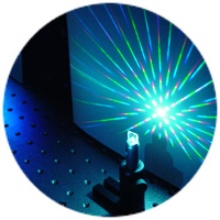Solid-state Laser Oscillators
The most promising laser materials for the generation of high-power femtosecond pulses with diode-pumped solid-state oscillators are Yb-doped crystals. We build up a passively mode-locked laser oscillator based on two Yb:KGW crystals. By this means, the pump power is split up among two crystals to overcome thermo-optical effects such as thermal lensing or crystal damage. With this simple, reliable, and cost efficient 1040 nm laser source we achieve 7.4 W average power at a repetition rate of 42 MHz and 425 fs pulse duration. We use this oscillator for example to generate white-light supercontinua in tapered fibers and obtain spectra spanning from 550 nm to over 1750 nm with a total power of 2.2 W and an excellent beam quality..
Further information: 7.4 W femtosecond oscillator
Parametric Oscillators and Amplifiers
To generate widely tunable femtosecond pulses, nonlinear frequency conversion with an optical parametric oscillator (OPO) or an optical parametric amplifier (OPA) is the method of choice. For these systems, periodically poled LiNbO3 and LiTaO3 crystals are used as nonlinear gain medium.
We employ multiple home-built OPO systems for near- and mid-infrared light generation. Pumped by the above mentioned Yb:KGW oscillator, our synchronously-pumped OPOs provide gap-free tunable femtosecond radiation in the 1.35 – 4.5 μm region with Watt-level output power. These sources are employed for Fourier-transform infrared (FITR) spectroscopy, as pump source for mid-infrared difference frequency generation (DFG), and for stimulated Raman scattering (SRS) microscopy.
Further information: 1.7 W OPO, FTIR spectroscopy with fiber-feedback OPO
While OPOs need very tight cavity length synchronization with the pump laser, our high-repetition rate OPAs are designed to be more simple and compact sources. A major disadvantage compared to OPOs is the need for a reliable seed. We recently investigated different types for seeding including cw lasers, optical solitons, and broadband supercontinua.
Further information: Supercontinuum-seeded OPA, Soliton-seeded OPA, cw-seeded OPA
Mid-infrared light generation
To extend the accessible spectral region into the 5 – 20 μm mid-infrared range non-oxide crystals such as GaSe and AgGaSe2, GaAs or CSP have to be employed. While CSP and GaSe allow for direct pumping with our Yb:KGW oscillator other crystals require longer pump wavelengths and are therefore pumped with the high-power near-infrared OPOs.
In a recent implementation a CSP-based OPO has been realized that shows record power levels in the mid-infrared of more than 100 mW at 7 μm for a high repetition rate system.
Further information: CSP OPO
With our near-infrared dual-signal-wavelength OPO, broadband mid-infrared radiation tunable between 10.5 μm and 16.5 μm with up to 4.3 mW average power can be generated by means of DFG in AgGaSe2. This source has been used for near-field imaging using a scanning near-field optical microscope (SNOM).
Further information: Mid-IR generation
A mid-infrared optical parametric amplifier has been realized that is directly pumped by the above mentioned Yb:KGW oscillator. A GaSe crystal is employed to achieve broadband mid-IR pulses tunable from 4.8 to 9.3 μm with up to 830 μW average power.
Nonlinear Fiber Optics
Another research topic is the use of highly nonlinear fibers such as liquid-filled capillaries and soft glasses, e.g. chalcogenides, tellurite, or ZBLAN. This concept enables new possibilities for nonlinear optics such as efficient white-light generation in materials that have significant larger optical nonlinearities compared with silica glass.
With our novel developed splicing method based on two-photon direct-laser writing we are able to mechanically splice different kinds of fibers together to fabricate handy integrated nonlinear devices.
Further information: Nonlinear refractive indices of liquids, Liquid-filled capillaries for supercontinuum generation
Stimulated Raman Scattering Microscopy
Coherent Raman scattering imaging techniques such as coherent anti-Stokes Raman scattering (CARS) or stimulated Raman scattering (SRS) are powerful tools to achieve chemical selectivity without labeling or chemical markers.
The nonlinear Raman gain is measured in terms of the energy transfer that occurs between the incident pump and Stokes beam. This effect takes place if the frequency difference of pump and Stokes beam matches the vibrational level of a molecular species on the sample. Hence, it allows identifying the chemical composition of a sample on the micro scale. Since this is a very tiny effect, sensitive lock-in detection and extremely low-noise laser sources with ultrashort pulses have to be used.
In our lab we demonstrate precise high-speed SRS imaging with a simple and compact cw-seeded OPA as tunable laser source for the pump beam. Simplifying the laser sources is a key issue for this technique to be established in biochemical and medical laboratories.
Further information: Compact laser source for SRS microscopy





